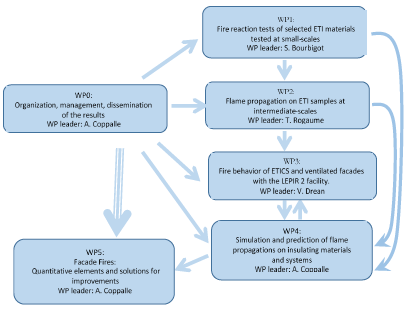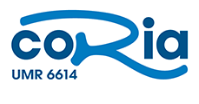Organisation et Etapes du projet
- WP0: organization, management, dissemination of the results
- WP1: fire reaction tests at small-scales of selected ETI materials
- WP2: Flame propagation on ETI samples at intermediate-scales
- WP3: Fire behavior of ETICS and ventilated facades with the LEPIR 2 facility
- WP4: Simulation and prediction of flame propagations on insulating materials
and systems - WP5: Facade Fires – Quantitative elements and solutions for improvements

WP0: organization, management, dissemination of the results
Task WP0-1: organization and management
Objective: to organize and to plan the important milestones. Monitoring of the time schedule and
the deliverable restitution.
Task WP0-2: ETI systems to be tested.
Objective: Feedback and analysis on facade fire accidents which occurred for several years. Definition of the typical scenarios involving both ETICs and ventilated claddings. A reduced number of representative systems of ETIs will be chosen after an analysis of the French market, and based on collaborations between the partners and different suppliers/manufacturers of ETI.
Task WP0-3: Dissemination of the results
The scientific and technical results will be presented in national and international conferences and diffused in international journals.A workshop will be organized at the end of the project for a large public and attendees coming from
all sectors involved in the facade fire safety.
Retour à l’organisation et étapes
WP1: fire reaction tests at small-scales of selected ETI materials
Task WP1-1: fire reaction of selected ETI materials tested at small-scales: results
Objective: The fire reaction properties of materials will be investigated on small samples with
Thermogravimetric analysis with coupled Fourier-Transform-Infrared spectrometer (FTIR),
Differential scanning calorimetry (DSC), and cone calorimeter
Task WP1-2: fire retardants for construction materials: Novel approaches and Results
Objective: New materials will be developed with a multi-conceptual approach (e.g. fire retardant in gas phase then relayed with an intumescent material). The properties of current and fire -retarded
materials will be then compared.
Task WP1-3: Analysis of fire retardant actions for ETI materials
Objectives: The experimental data obtained in tasks WP1-1 et WP1-2 will be analyzed to understand materials flammability, ignition and burning behavior and to characterize the thermal decomposition kinetics and pyrolysis models which will be coupled with CFD simulations carried out for larger scale tests
Retour à l’organisation et étapes
WP2: Flame propagation on ETI samples at intermediate-scales
Task WP2-1: Conception, development and construction of a new test bench at intermediate-scale.
Objective: Definition of the specifications in order to test ETI samples with typically 0.5m 2 size, offering capability to install all the experimental setup need to achieve the objectives. De finition of the specifications of the burner needed to simulate the thermal stresses applied to samples and representative of real accidents. Construction of the bench test at Pprime laboratory. This bench scale will be able to characterize the interaction between the flame and the facade in order to distinguish the part due to the thermal decomposition of the material to the one due to the combustion into the gas phase (flame zone). The different scenarios (I, II, and III) will be characterized to be able to study the interactions between the thermal decomposition, the flame, there interactions depending on the scenarios, and the consideration of the impact of an air layer. In order to be able to respond to this challenge, different thermal solicitations will be performed (radiant panel and gas burner), at different power and for different geometries, representative of the 3 scenarios. A special attention will also be kept to the thermal exchange between the flame and thesolid fuel (facade) and the gaseous emissions will be quantified.
Task WP2-2: Tests of combustibility of panels.
Objective: panels of plastic materials used in ETICS will be ignited on their surface to focus on flame propagation. These tests must be fully instrumented in order to obtain enough data for the validation of their simulation with FDS and openFoam CFD tools. So the test bench will be equipped with exhaustive measurement facilities: thermocouple, IR and visible cameras, and heat flux sensors on the sample. Smoke toxicity will be analyzed using gas analyzers and FTIR spectrometer. The laser diagnostic PIV will be applied to determine the velocity field close to the panels and so the different boundary layers.
Task WP2-3: The fire behavior of the singularities of the construction solutions.
Objective: to look at the interaction flame-panel and at the development of fire through the insulating systems, tests will be performed on several samples of ETICs with both the burner against and under the sample and different burner powers. So it will be possible to focus on the behavior of the singularities of the construction solutions, as the edges or part of a window frame when they are stressed by a fire source. The tested ETICs have been chosen in task WP0-2.
Task WP2-4: Heat flux measurements and flame imaging
Objective: At intermediate-scale, the inclusion of a heat flux sensor in the sample need some caution to avoid disturbances on fluid flow and heat exchange at the wall. A lot of Image processing are available, but some of them are more suitable for flame imaging. In this task, the measurement methods will be analyzed to highlight the most convenient technics for accurate observations during panel burning tests. In particular, comparisons between accurate and expensive heat flux sensor s and cheaper one, which may be home-made, will be done, in order to prepare heat flux
Retour à l’organisation et étapes
WP3: Fire behavior of ETICS and ventilated facades with the LEPIR 2 facility
Task WP3-1: Tests and results with the LEPIR 2
Objective: to analyze the fire behavior of current insulating systems (ETICS and ventilated). 3 different tests will be done. For each test, the LEPIR 2 facade will be divided in the vertical directi on, allowing installing on the facade two different isolation systems. So 4 ETICS and 2 ventilated systems will be tested, with a flame emerging from a compartment.
Task WP3-2: Inter-comparison of heat flux measurement methods and flame image processing
Objective: During a Lepir 2 test, an inter-comparison of the heat flux measurement methods and the image processing of flames will be proposed to national and international laboratories. This benchmark exercise aims to determine if these non-standard measurements can be applied and are relevant for large-scale tests in order to obtain suitable data and needed to improve the understanding of phenomena and make recommendations for the test standards in the future.
Task WP3-3: Lessons learnt from the LEPIR 2 tests
Objective: Several performance criteria will have to be defined for ETICs and venti l ated systems to evaluate or to rank their performance in term of fire safety. Some recent studies have i ntroduced a multi-criteria performance index named ‘flammability’ (different from combustibility) 27-28 , referring to the ease of fire to ignite and spread through the facade. Currently, no such performance criteria is well defined and quantified, but the aim is to create ones. This will be done from the data obtained in task WP3-1 and also with the knowledge gained in WP2. In view of these criteria, it will be possible (I) to assess the performance of the LEPIR 2 facility, and (ii) to make recommendations for its utilization and its future evolutions.
Retour à l’organisation et étapes
WP4: Simulation and prediction of flame propagations on insulating materials
and systems
Task WP4-1: Simulation and Prediction of the combustibility of panels
Objective: Numerical simulations will be carried out to evaluate the ability of the numerical tool s to reproduce quantitative results in terms of velocities, temperatures and heat fluxes, and flame spread on combustible panels tested in task WP2-2. For these academic test cases, it will be important to look at the performances and weaknesses of sub-models included in the software packages used for simulating the fire dynamic of facade fires (FDS and fireFoam).
Task WP4-2: Simulation and Prediction of the behavior of ETICS and ventilated facades under fire
Objective: Numerical simulations will be carried out to evaluate the ability of the numerical tool s to eproduce quantitative results in terms of gas temperatures and heat fluxes close to the tested facades with the LEPIR 2 tests. This is an important step before engineering applications, i .e before the fire performances of any insulation system can be predicted by numerical tools. The involvement of the two different CFD codes will also enable to conduct some benchmark studies on selected scenarios. The results from such benchmark studies can provide valuable information to the researchers and engineers who use different codes and the regulators who have to assess performance based designs involving predictions by different consultants and CFD codes.
Retour à l’organisation et étapes
WP5: Facade Fires – Quantitative elements and solutions for improvements
Objectives:
-To summarize the most important scientific and technical results obtained at the different scales.
-To highlight the added values of project and the complementarities between the different scale tests.
-To demonstrate the fire reaction improvement using the fire retarded materials developed in WP1
-To show the state of art of the modelling of the fire reaction and flame propagation of ETI systems.
– To propose some numerical models permitting to simulate the specific fire behavior of ETI syste ms whatever the configurations.
-To deliver quantitative elements and solution improvements for actors involved in the facade systems (manufacturers, engineers, architects and town planners, fire fighters…)





